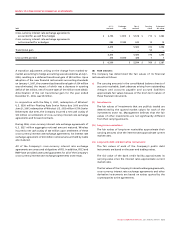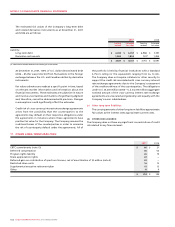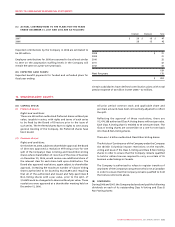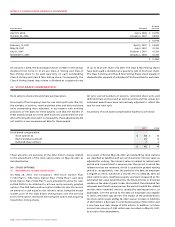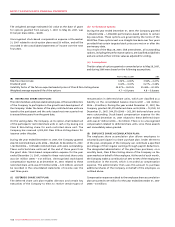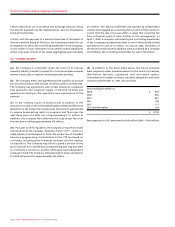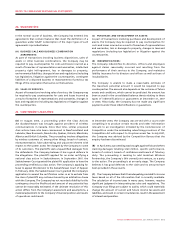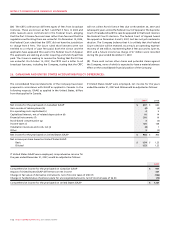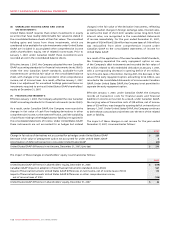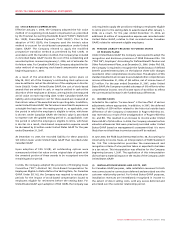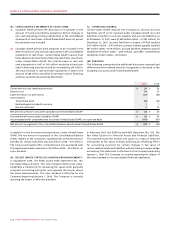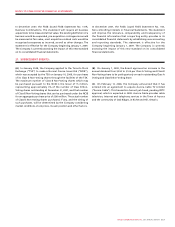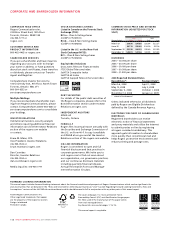Rogers 2007 Annual Report Download - page 115
Download and view the complete annual report
Please find page 115 of the 2007 Rogers annual report below. You can navigate through the pages in the report by either clicking on the pages listed below, or by using the keyword search tool below to find specific information within the annual report.
ROGERS COMMUNICATIONS INC. 2007 ANNUAL REPORT 111
NOTES TO CONSOLIDATED FINANCIAL STATEMENTS
In the normal course of business, the Company has entered into
agreements that contain features that meet the definition of a
guarantee under GAAP. A description of the major types of such
agreements is provided below:
(A) BUSINESS SALE AND BUSINESS COMBINATION
AGREEMENTS:
As part of transactions involving business dispositions, sales of
assets or other business combinations, the Company may be
required to pay counterparties for costs and losses incurred as a
result of breaches of representations and warranties, intellectual
property right infringement, loss or damages to property,
environmental liabilities, changes in laws and regulations (including
tax legislation), litigation against the counterparties, contingent
liabilities of a disposed business or reassessments of previous tax
filings of the corporation that carries on the business.
(B) SALES OF SERVICES:
As part of transactions involving sales of services, the Company may
be required to pay counterparties for costs and losses incurred as
a result of breaches of representations and warranties, changes in
laws and regulations (including tax legislation) or litigation against
the counterparties.
(A) In August 2004, a proceeding under the Class Actions
Act (Saskatchewan) was brought against providers of wireless
communications in Canada. Since that time, similar proposed
class actions have also been commenced in Newfoundland and
Labrador, New Brunswick, Nova Scotia, Québec, Ontario, Manitoba,
Alberta and British Columbia. The proceeding involves allegations
by wireless customers of, among other things, breach of contract,
misrepresentation, false advertising and unjust enrichment with
respect to the system access fee charged by the Company to some
of its customers. The plaintiffs seek unquantified damages from
the defendants. The Company believes it has a good defence to
the allegations. The plaintiffs applied for an order certifying a
national class action in Saskatchewan. In September 2007, the
Saskatchewan Court granted the plaintiffs’ application to have the
proceeding certified as a class action. The Company is applying for
leave to appeal this decision to the Saskatchewan Court of Appeal.
In February 2008, the Saskatchewan Court granted the Company’s
application to amend the certification order so as to exclude from
the class of plaintiffs any customer bound by an arbitration clause
with the Company. The Company has not recorded a liability for this
contingency since the likelihood and amount of any potential loss
cannot be reasonably estimated. If the ultimate resolution of this
action differs from the Company’s assessment and assumptions, a
material adjustment to the Company’s financial position and results
of operations could result.
(C) PURCHASES AND DEVELOPMENT OF ASSETS:
As part of transactions involving purchases and development of
assets, the Company may be required to pay counterparties for
costs and losses incurred as a result of breaches of representations
and warranties, loss or damages to property, changes in laws and
regulations (including tax legislation) or litigation against the
counterparties.
(D) INDEMNIFICATIONS:
The Company indemnifies its directors, officers and employees
against claims reasonably incurred and resulting from the
performance of their services to the Company, and maintains
liability insurance for its directors and officers as well as those of
its subsidiaries.
The Company is unable to make a reasonable estimate of
the maximum potential amount it would be required to pay
counterparties. The amount also depends on the outcome of future
events and conditions, which cannot be predicted. No amount has
been accrued in the consolidated balance sheets relating to these
types of indemnifications or guarantees at December 31, 2007
or 2006. Historically, the Company has not made any significant
payments under these indemnifications or guarantees.
In December 2004, the Company was served with a court order
compelling it to produce certain records and other information
relevant to an investigation initiated by the Commissioner of
Competition under the misleading advertising provisions of the
Competition Act with respect to its system access fee. In July 2007,
the Company was advised by the Competition Bureau that the
enquiry has been discontinued.
(B) In April 2004, a proceeding was brought against Fido and others
claiming damages totalling $160 million, specific performance,
breach of contract, breach of confidence and breach of fiduciary
duty. The proceeding is seeking to add Inukshuk Wireless
Partnership, the Company’s 50% owned joint venture, as a party
to the action. The proceeding is at an early stage. The Company
believes it has good defences to the claim and no amounts have
been provided in the accounts.
(C) The Company believes that it has adequately provided for income
taxes based on all of the information that is currently available.
The calculation of income taxes in many cases, however, requires
significant judgment in interpreting tax rules and regulations. The
Company’s tax filings are subject to audits, which could materially
change the amount of current and future income tax assets and
liabilities, and could, in certain circumstances, result in the assessment
of interest and penalties.
24. GUARANTEES:
25. CONTINGENT LIABILITIES:


